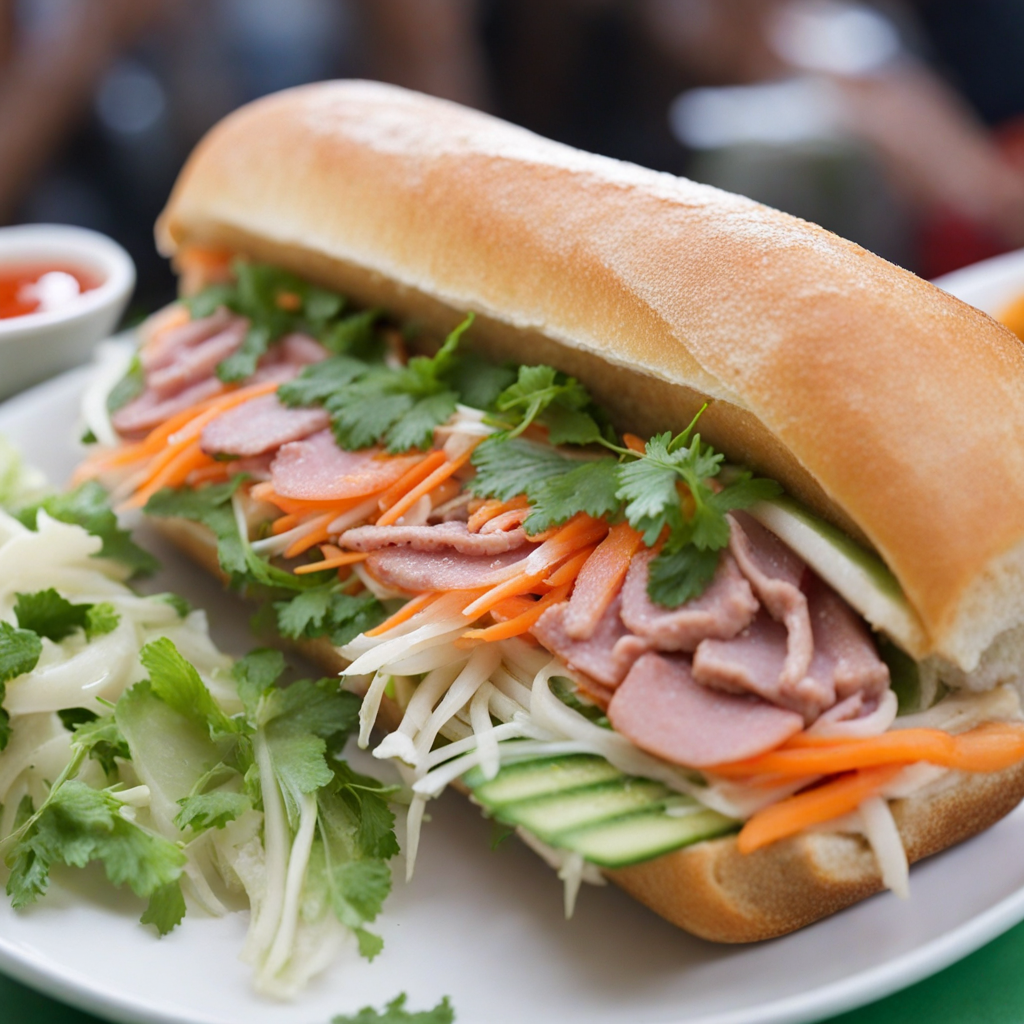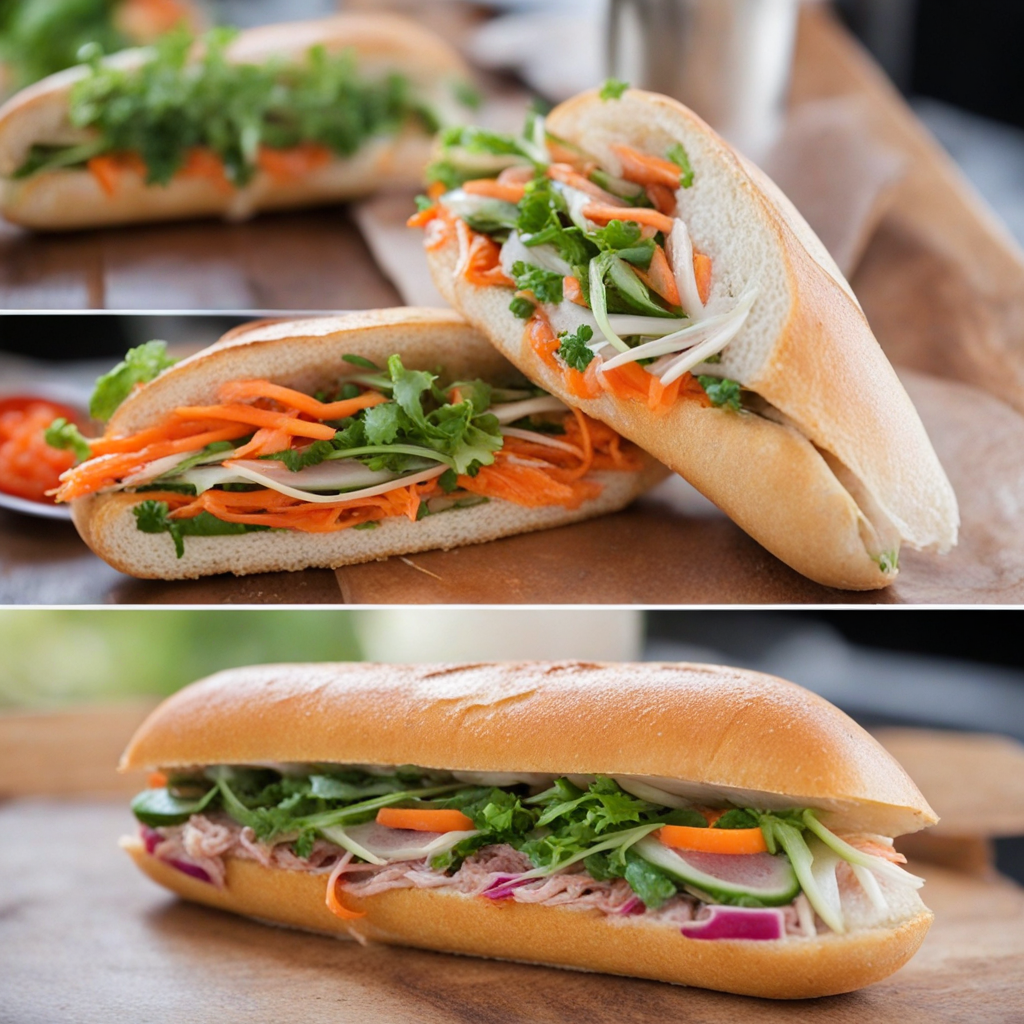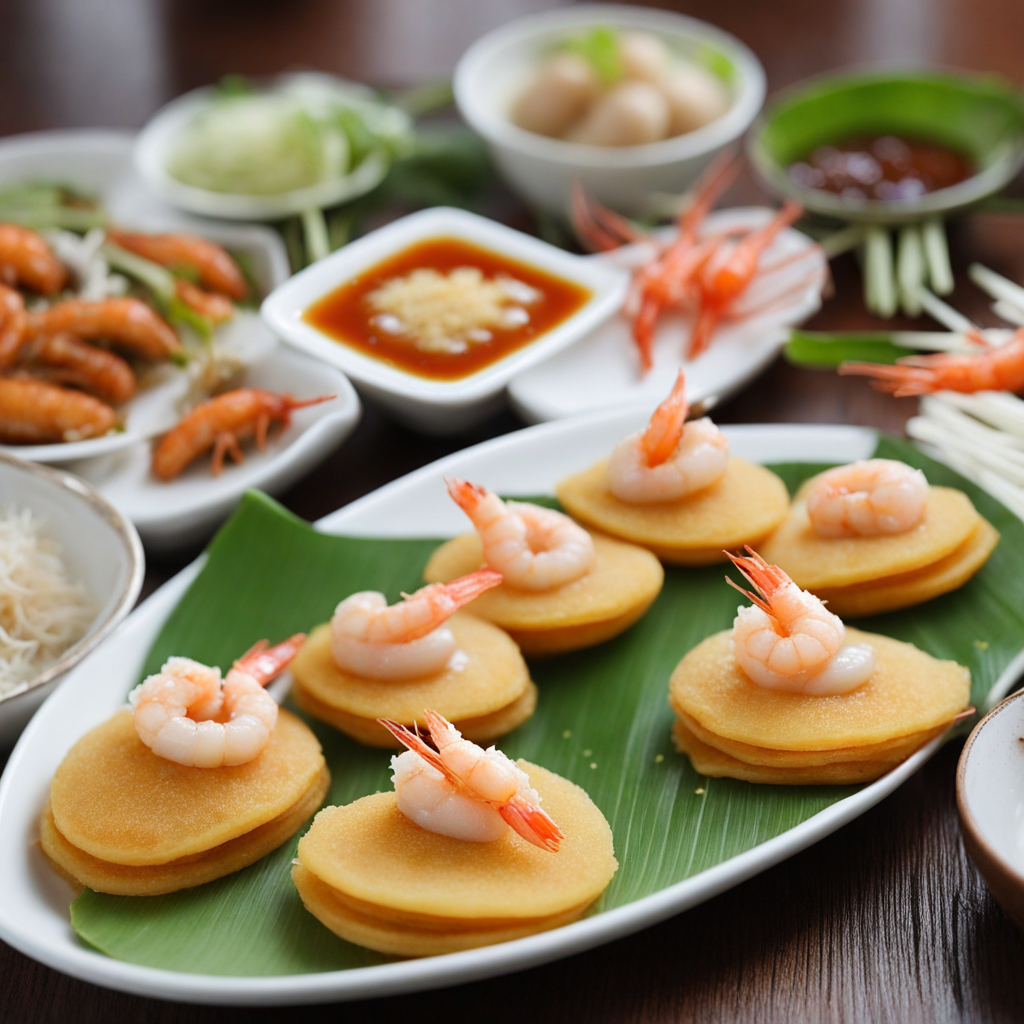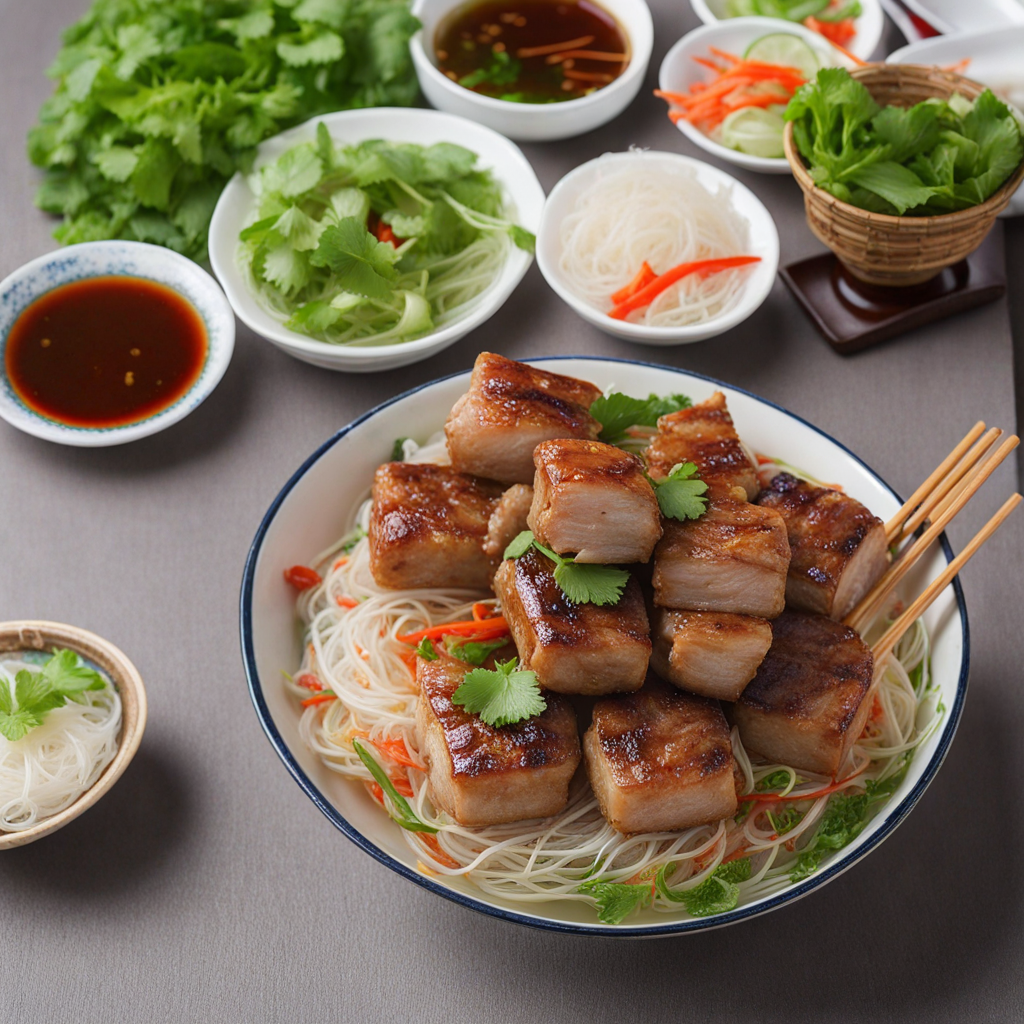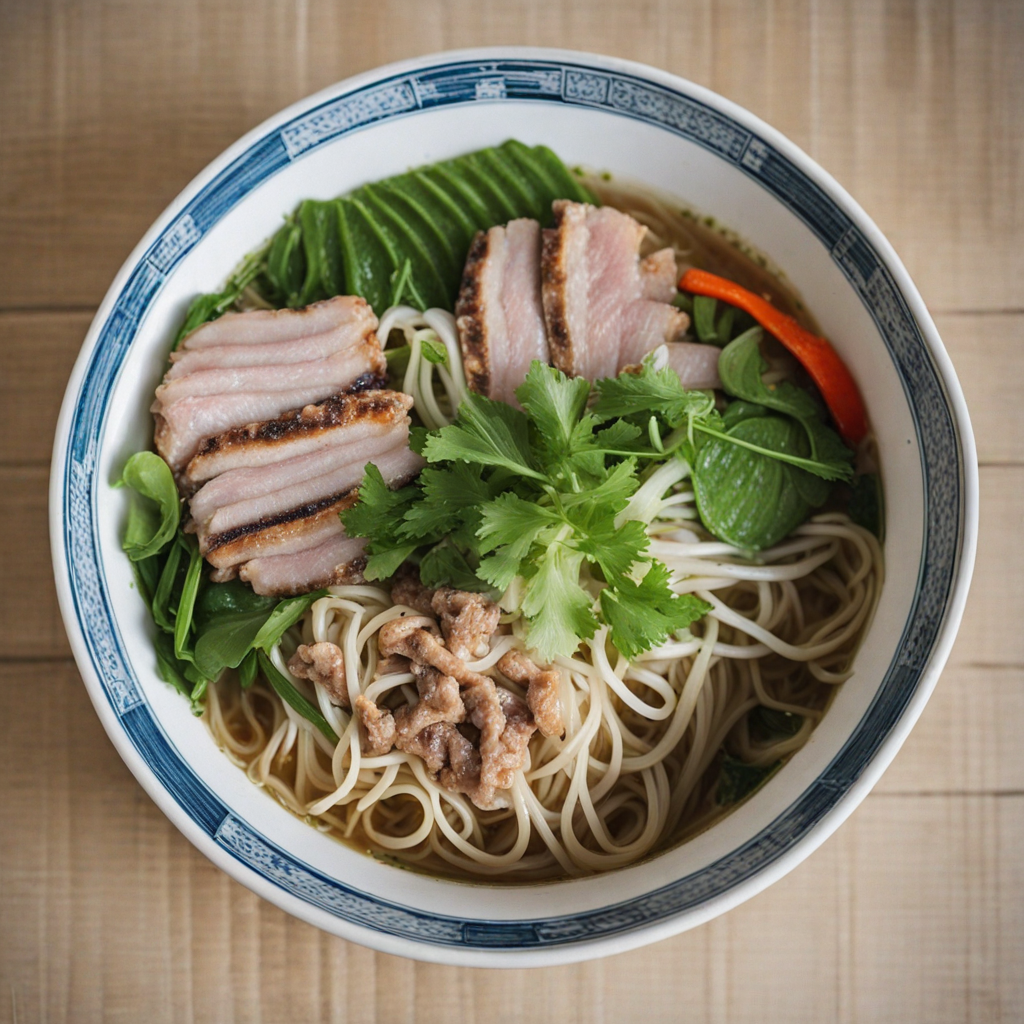Banh Mi
Banh Mi is a vibrant Vietnamese sandwich that beautifully marries the influences of French colonialism with traditional Vietnamese flavors. At its core, it features a crispy baguette, which is a nod to the French bread, characterized by its light, airy interior and a crunchy crust. This delightful bread serves as the vessel for an array of fillings, making each Banh Mi a unique culinary experience. The choice of fillings often includes succulent grilled meats, such as pork, chicken, or beef, marinated in a blend of aromatic spices and herbs, imparting a depth of flavor that is both savory and satisfying. The sandwich is often layered with a variety of fresh vegetables, including pickled carrots and daikon radish, which provide a tangy crunch that complements the richness of the meats. Fresh cucumber slices add a refreshing crunch, while cilantro and jalapeños introduce a vibrant brightness and a hint of heat. Together, these ingredients create a harmonious balance of textures and flavors, making each bite of Banh Mi a delightful journey through sweet, sour, salty, and spicy notes. What truly sets Banh Mi apart is the array of sauces and spreads that are often added. A smear of mayonnaise adds creaminess, while a drizzle of soy sauce or chili sauce can elevate the flavor profile to new heights. Each region in Vietnam may offer its own twist on this classic sandwich, incorporating local ingredients and flavors, ensuring that no two Banh Mi are exactly alike. This delightful fusion of flavors and textures makes Banh Mi not just a meal, but a celebration of Vietnamese culinary art that invites everyone to discover a new taste sensation.
How It Became This Dish
The History of Bánh Mì: Vietnam's Culinary Icon #### Origins: French Colonial Influence Bánh mì, a term that simply means "bread" in Vietnamese, is a delightful sandwich that encapsulates the intricate tapestry of Vietnam's culinary history. Its origins can be traced back to the French colonial period in the 19th century when Vietnam was under French rule from 1858 to 1954. The French introduced a variety of culinary elements, including the baguette, which became an integral part of Vietnamese cuisine. The French baguette was adapted to local tastes and conditions. The Vietnamese version is typically lighter, crustier, and shorter than its French counterpart. This adaptation was necessary due to the availability of local ingredients and baking techniques. The baguette served as a blank canvas for a myriad of fillings that would eventually define the bánh mì. #### The Birth of the Bánh Mì Sandwich By the early 20th century, street vendors in cities like Saigon (now Ho Chi Minh City) began to fill the baguettes with local ingredients, giving birth to what we now recognize as the bánh mì sandwich. The traditional bánh mì is a harmonious blend of French and Vietnamese culinary practices. It usually consists of a crispy baguette filled with an assortment of ingredients, including grilled meats (like pork, chicken, or beef), pickled vegetables (typically daikon and carrots), fresh herbs (such as cilantro and mint), and condiments like mayonnaise, soy sauce, or chili sauce. The innovation of bánh mì was deeply rooted in the Vietnamese practice of street food culture, which dates back centuries. Street vendors, known as "gánh hàng rong," played a pivotal role in making food accessible to all social classes. Bánh mì quickly became a beloved dish, embodying the resourcefulness and creativity of the Vietnamese people in transforming foreign influence into a uniquely local delicacy. #### Cultural Significance Bánh mì is not just a sandwich; it is a symbol of Vietnamese identity and resilience. The dish reflects the country’s colonial past while also showcasing its ability to adapt and evolve. The melding of French and Vietnamese flavors represents a broader narrative of cultural exchange and fusion. During the Vietnam War (1955-1975), bánh mì became a staple for soldiers and civilians alike. Its portability and variety made it an ideal food for those on the go. It provided sustenance during a tumultuous time, reinforcing its status as a comfort food. After the war, as Vietnamese people began to migrate around the world, they took their culinary traditions with them, introducing bánh mì to international palates. #### Development Over Time In the years following the Vietnam War, especially during the 1980s and 1990s, bánh mì began to gain traction outside of Vietnam. Vietnamese diaspora communities in places like the United States, Canada, and Australia started to open restaurants and food stalls that showcased traditional Vietnamese cuisine, with bánh mì often taking center stage. As Vietnamese food gained popularity globally, bánh mì evolved to include a wider variety of fillings and styles. While traditional versions remain beloved, modern interpretations have emerged, incorporating diverse ingredients such as tofu, seafood, and even fusion elements like kimchi. This evolution reflects the dynamic nature of food culture, adapting to local tastes and available ingredients while staying true to its roots. In the United States, particularly in cities like San Francisco and Los Angeles, bánh mì has become a prominent feature of the culinary landscape. Food trucks and restaurants have embraced the sandwich, offering unique spins that cater to contemporary tastes. The rise of food blogs and social media has also played a crucial role in popularizing bánh mì, showcasing its vibrant colors and mouthwatering flavors to a global audience. #### The Anatomy of a Bánh Mì A traditional bánh mì is a perfect balance of flavors and textures. The crispy crust of the baguette contrasts beautifully with the tender fillings. The pickled vegetables add a zesty crunch, while fresh herbs lend a fragrant note. The choice of protein can vary widely, ranging from classic options like grilled pork (bánh mì thịt nướng) to more modern takes that include fried egg, beef, or even vegan options featuring marinated tofu. The condiments are equally important. The use of mayonnaise—often a remnant of French influence—adds creaminess, while chili sauce can introduce a spicy kick. The layering of these elements transforms a simple sandwich into a complex dish that is both satisfying and deeply flavorful. #### The Bánh Mì Today Today, bánh mì is celebrated not only as a street food staple in Vietnam but also as a global phenomenon. It is a dish that continues to evolve, reflecting the shifting landscape of culinary preferences and cultural identities. Chefs around the world experiment with the sandwich, introducing regional ingredients and techniques to create new interpretations while honoring its traditional roots. The bánh mì's adaptability is part of its enduring appeal. Whether enjoyed at a bustling street stall in Ho Chi Minh City or from a trendy café in New York City, bánh mì remains a testament to the rich history of Vietnam's culinary heritage. It is a dish that brings people together, sparking conversations about food, culture, and identity. #### Conclusion The history of bánh mì is a reflection of Vietnam itself: a rich tapestry of cultural influences, resilience, and creativity. From its humble beginnings as a fusion of French and Vietnamese culinary practices to its current status as a global food icon, bánh mì embodies the spirit of adaptation and innovation. As it continues to evolve and inspire, bánh mì stands as a delicious reminder of the power of food to transcend borders and connect people across the globe. Whether one enjoys a classic version or a modern twist, each bite of bánh mì tells a story—one of history, culture, and the enduring love for good food.
You may like
Discover local flavors from Vietnam


